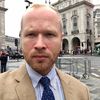
It’s a hopeless task, you think, when Bashar Haalo fetches his broom. Sweeping the floors of his home in the Syrian city of Homs – once the ”capital of the revolution,” now reduced to rubble – isn’t going to change the fact that the whole apartment building is completely perforated.
Mr. Haalo doesn’t agree.
“I’m glad it’s not as bad as I thought,” he says in the new Swedish documentary series “Culture in danger” (”Kultur i farozonen”).
But a few frames later we see for ourselves why he clings to something seemingly long lost. As the track of his mop wipes away a thick layer of dust, a breathtaking marble floor with a myriad of colors bursts through.
“Sometimes when I show that segment to people I close my eyes and just wait and listen to their reaction,” says Khazar Fatemi, the Swedish filmmaker behind the documentary.
It’s just one man’s apartment, but it’s telling for all the beauty lost in a war. His optimism, however, is the real reason why Ms. Fatemi wants to share the story.
“It’s about identity,” she says of her series, now showing on Sweden’s state-run broadcasting network, SVT. “You sometimes forget about these people who stay behind to save the culture which is such a big part of who they are.”
Khazar Fatemi knows this first hand. Her parents fled Iran in the early ‘80s and temporarily found refuge in Afghanistan, where they raised her for seven years, before coming to Sweden.
Her own story is very much part of her new six-episode documentary. She says it’s a way of paying back the debt to her parents who gave her the chance of a new life. She’ll now use that to give voice to the people who sacrifice in a different way, staying behind and caring for a culture’s heritage.
“I guess, for this season, we went to places that are known and where it’s happening right now. But our goal and our responsibility is to look for, and find, the voices that aren’t being heard,” she says.
After two episodes taking place in Syria – mainly in Damascus, Homs and Palmyra – Ms. Fatemi turns to the United States and North Dakota to join the native Americans who struggle against ”Dakota Access,” a pipeline project that will cut through their land, and, if it breaks, poison the nature they love more than anything.
That’s where Khazar Fatemi realized the similarities to the struggles in the Middle East and how the culture and the identity it gives always takes a huge hit.
“I hope the viewers realize that it’s not just someone else’s culture and someone else’s environment – it’s all ours,” she says.
Even though “Culture in danger” is not new per se (viewers might recognize the name from its two previous seasons), the show is very different now that Fatemi is running it. She’s done segments as a field producer for the previous installments too, but this time around she and her team are running the entire project. It has given it a lift.
The format is also widely un-Swedish. Especially for the state run SVT network, known for it’s nonpartisan, fact-based and somewhat bourgeois reporting. Here, Ms. Fatemi isn’t just the interviewer who meets people on the street. She’s closely engaged in the conversations and shares every moment of the reporting – whether it’s sudden tears or moments of confusion. Her own background is also a constant tool in building trust, which really works. The people she talk to seem more than willing to open up, knowing she’ll understand their struggle.
“I have to give a lot of credit to my team for much of it. They aren’t a news crew and therefore aren’t bound by traditional news making rules,” she says of the raw portrayals.
And so far, with two episodes aired, viewers are responding very well, she says. So well that SVT have already ordered a second season with her as the anchoring reporter.
“We covered a lot of the Middle East and a little of the U.S. in this season.” (Other than the U.S. and Syria, she’ll visit Afghanistan and Iraqi Kurdistan). “For next season we’ll probably look somewhere else. I’m very interested in South American culture as well as African culture.”
Culture in Danger (Kultur i farozonen) can be seen on Sweden’s SVT and svtplay.se.
